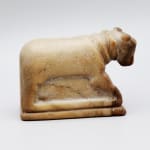Sabean Figure of a Cow, Second to Third Centuries AD
Chalcedony
7.7 x 4.2 x 11.1 cm
3 x 1 5/8 x 4 3/8 in
3 x 1 5/8 x 4 3/8 in
CC.172
Further images
-
(View a larger image of thumbnail 1
)

-
(View a larger image of thumbnail 2
)

-
(View a larger image of thumbnail 3
)

-
(View a larger image of thumbnail 4
)

-
(View a larger image of thumbnail 5
)

-
(View a larger image of thumbnail 6
)

-
(View a larger image of thumbnail 7
)

-
(View a larger image of thumbnail 8
)

-
(View a larger image of thumbnail 9
)

-
(View a larger image of thumbnail 10
)

The story of the Queen of Sheba, who visited King Solomon with a vast retinue and ‘with camels bearing spices, and very much gold, and precious stones’ (1 Kings 10:2)...
The story of the Queen of Sheba, who visited King Solomon with a vast retinue and ‘with camels bearing spices, and very much gold, and precious stones’ (1 Kings 10:2) in order to test his wisdom, is probably a Sixth Century BC fabrication, but archaeologists believe that it reflects a real place at the centre of important trade routes and famed for its fabulous wealth. That place was Saba’, a kingdom occupying much of the territory of modern Yemen. When exactly Saba’ was founded is unclear. Some, including renowned archaeologist Kenneth Kitchen, date the earliest Sabaean finds to c. 1200 BC, while more recent assessments place them around the Eighth Century BC, implying that the Biblical Sheba must have been elsewhere. Their kingdom seems to have originated from a confederation of communities (sha’bs) fringing the desert, which were unified under one ruler (‘mlk) who took on the title ‘Mukarrib of the Sabaeans’ (mkrb sb’). By the First Century BC, the kingdom had been conquered by the Himyarites, a rival faction who competed for control of South Arabia. The Sabaeans re-emerged around the turn of the Second Century AD, and remained independent until they were conquered once more by the Himyarites and consigned to history.
This delightful representation of a cow comes from the exotic and cosmopolitan milieu of Saba’, which was strategically located at the entrances to both the Persian Gulf and the Red Sea. Sabaean sculpture is well-known for its robust forms, and lively depictions of animals. This cow reflects both characteristics. She is depicted in a striding position, forelegs forward, rear legs stationary. Her nearly cylindrical body bears indications of firm, undulating bovine musculature. Her neck is defined by skin-folds, which are characteristic in Sabaean representations of cattle (see British Museum 135562 and Metropolitan Museum of Art 47.100.85). Her face is finely modelled, with closed eyes, a delicate muzzle, and little nub ears. The space between her legs has not been vacated, in a commonplace of Sabaean sculpture.
The importance of cattle in Saba’ can be guessed at, but is largely unknown. In common with other ancient cultures, cattle would have been important pack and meat animals, though milk was likely only used for infants and the infirm. Cattle were probably also an indicator of economic wealth – in many Near Eastern cultures, cattle were the first form of ‘currency’, a medium of exchange for high-value purchases. In religion, the bull was associated with ‘Attar, the moon god, who was considered the ultimate authority in the universe. It is possible – though by no means certain – that the cow represented his female counterpart, Shams, the goddess of the sun. Indeed, Shams was associated by syncretism with the Egyptian goddess Isis, whose own symbol was the cow.
This delightful representation of a cow comes from the exotic and cosmopolitan milieu of Saba’, which was strategically located at the entrances to both the Persian Gulf and the Red Sea. Sabaean sculpture is well-known for its robust forms, and lively depictions of animals. This cow reflects both characteristics. She is depicted in a striding position, forelegs forward, rear legs stationary. Her nearly cylindrical body bears indications of firm, undulating bovine musculature. Her neck is defined by skin-folds, which are characteristic in Sabaean representations of cattle (see British Museum 135562 and Metropolitan Museum of Art 47.100.85). Her face is finely modelled, with closed eyes, a delicate muzzle, and little nub ears. The space between her legs has not been vacated, in a commonplace of Sabaean sculpture.
The importance of cattle in Saba’ can be guessed at, but is largely unknown. In common with other ancient cultures, cattle would have been important pack and meat animals, though milk was likely only used for infants and the infirm. Cattle were probably also an indicator of economic wealth – in many Near Eastern cultures, cattle were the first form of ‘currency’, a medium of exchange for high-value purchases. In religion, the bull was associated with ‘Attar, the moon god, who was considered the ultimate authority in the universe. It is possible – though by no means certain – that the cow represented his female counterpart, Shams, the goddess of the sun. Indeed, Shams was associated by syncretism with the Egyptian goddess Isis, whose own symbol was the cow.









